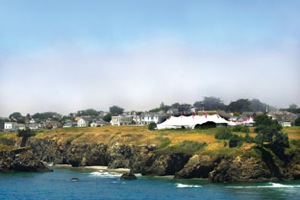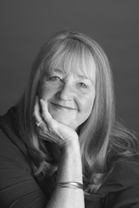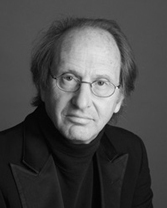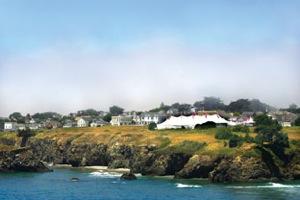
Photo by Nick Wilson
Glimpses of the landscape of American music, as played, sung, and illustrated by projections and narration, will be displayed in a big tent on the headlands at Mendocino, one of the most striking land-and-seascapes on the West Coast. This compound setting for Susan Waterfall’s narrated multimedia program on July 15, “Hallelujah, America!” will be a featured event of the 24th Mendocino Music Festival, July 10-24.
“From the beginning,” Waterfall said, “Allan [Pollack, her husband and cofounder, with her, of the festival] and I believed the Music Festival to be a quintessential celebration of place, the yearly ritual of great and challenging music performed and experienced on the Mendocino headlands by a generous and welcoming community.”
The program is eclectic — and, yes, challenging. It will include Aaron Copland (the Andante from his Clarinet Concerto, played on piano and clarinet, and Poems of Emily Dickinson); songs by Charles Ives, Ned Rorem, and Leonard Bernstein; John Cage and Lou Harrison's Double Music (1941) for four percussionists; George Crumb's Music of the Starry Night (1974), for two amplified pianos and two percussionists; and John Adams' Hallelujah Junction. Waterfall herself will double at playing piano and narrating. Photographs and artwork related to the music, setting it in context, will be projected on screens in the festival tent.
“Music enables the experience of places and periods of history,” Waterfall said, expanding on the “landscapes” theme, “by appealing to the layers of the psyche that only music can reach. Like Proust’s madeleine, music transports us by involuntary memories and recognitions. When the power of music is supported by a good narrative, photographs, and art, you can conjure the era and the place — the context for the composer’s creativity.”

Photo by John Blaustein
The story of Waterfall’s multimedia shows — and of the Mendocino Music Festival itself — is one of happy serendipity and ongoing collaboration between friends, family, fellow musicians, and community members.
“It just grew and grew,” Pollack said. “The tent’s now 16,000 square feet, seating 800. We put on 24 concerts, in different venues. We’ve gone from a budget of $74,000 — and we made $6,000 that first year, with everybody practically doing it for free — to about $500,000. A huge orchestra comes up. We now have jazz, bluegrass, dance, and other kinds of music besides classical.
Waterfall and Pollack’s son, Julian Waterfall Pollack, was born three weeks before the second festival. “He was literally at his mother’s breast,” Pollack recalled — “and got passed back and forth among the musicians at rehearsals.” Coming from a musical family, as a little boy Julian used to “approach strangers on the street and ask, ‘What instrument do you play?’”

Photo by John Blaustein
Now a rising young jazz pianist, band leader, and songwriter in New York, who just finished touring to promote his second CD, Julian said he feels the festival’s his “big brother.” He has already performed in it for over a decade, debuting for his mother’s multimedia programs with Debussy’s Gollywog’s Cakewalk.
He’ll also be playing one of the pianos, with his mother on the other, on John Adams’ Hallelujah Junction. He has known the composer since “me and his son Sam went to school together. We both played bass and piano; both our fathers were composer-conductors. In eighth grade we’d play a lot of jazz together; John would come down to listen to us. If that happened again, I think I’d stop playing!” Recalling hearing some of Adams’ music a few years ago in New York, Julian said, “I hadn’t heard anything for a long while that was so beautiful. It speaks to my generation in its harmonics and repetition, what you hear a lot in indie music.”
After hearing the Adams music, Julian bought a copy of his complete piano music, discovered Hallelujah Junction, and promoted doing it at the festival to his mother, “and now I think she loves it more than I do.”
Pollack concluded with an irresistible pitch: “The Mendocino Music Festival has, as a hook to bring people in, the spectacular setting — and intimacy on a high level, the opportunity to listen close up, to feel you’ve really participated. You can see the rosin on the bow.”

